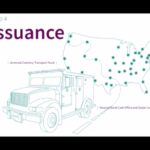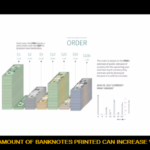How Do Rare Banknotes Get Into Circulation? It’s important to know the critical steps it takes to get a Federal Reserve note into circulation. Some of these steps actually play into its collectible factor. So first you got to realize that before a Federal Reserve note even enters circulation and can land in your hand, after you go to that next fast food joint, it must pass through four critical steps. Those steps are design, order, production and issuance.
Step number one is the design of the banknote. US Currency begins in the design process, which is actually an interagency effort between the Federal Reserve, the US Department of the Treasury’s bureau of Engraving and Printing and actually the US Secret Service. The Secretary of the treasury has final approval of designs for banknotes in the US.
After this process, they go to step two, which is the order. The Federal Reserve Board places an order for currency from the US Treasury Department’s Bureau of Engraving and Printing every single year. The order is based on how much currency will be demanded by the public in the coming year and by how much currency we expect reserve banks will destroy because the notes are just unfit to circulate anymore or because of other factors like inventory management or the issuance of a new design of a bill, which is actually coming over the next ten years.
After this step, it goes to production. The Bureau of Engraving and Printing receives the print order and manufactures Federal Reserve notes at its facilities in Washington, DC and Fort Worth, Texas. To get a more detailed look of how the banknotes are made, you can watch my video. Specifically on the production of banknotes. There’s a link to that in the description box.
After the production of the notes at these two locations in DC and Texas, we go on to step four, which is issuance of the banknotes. The Federal Reserve Board pays the Bureau of Engraving and Printing for the cost of printing currency and arranges and pays for the transport of that currency from the Bureau of Engraving and Printing facilities in Washington, DC and Fort Worth to Federal Reserve Bank cash offices. As the issuing authority, the Federal Reserve Board turns the pieces of paper manufactured at the Bureau of Engraving and Printing into legal tender.
This, of course, technically brings us to a step five, but this is circulation of those banknotes. Federal Reserve Bank cash offices distribute banknotes to the public through depository institutions such as banks, credit unions, and savings and loans associations. Federal Reserve banks are responsible for processing banknotes to ensure that they are genuine and fit for recirculation. If the bank notes are not genuine, Federal Reserve banks send them to the US. Secret Service. If they are genuine and still in good condition, the notes are sent to depository institutions to fill new orders for currency.
Our Site: http://www.varietyerrors.com
My Book on Amazon: https://www.amazon.com/dp/1693896982
LIKE AND SUBSCRIBE IF YOU ENJOYED THE VIDEO!
AND…
Remember… Always check your bills!
Serial numbers, miscuts, and errors of all kinds can make their way into your pocket or wallet. These can be worth hundreds of dollars to thousands of dollars!
Comment or email us any questions or suggestions for videos on coins, bills and other banknotes, precious metals and more!
Don’t forget to like and subscribe to our YouTube Channel so we can build the community and stay in touch!╝















